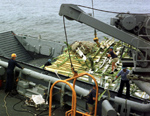Safety Board Finalizes TWA 800 Findings
By Jim Mathews
18-Jan-2001 12:47 PM U.S. EST

U.S. safety investigators have issued their final report on the 1996 crash of TWA Flight 800 that killed all 230 aboard, confirming that a center fuel tank explosion probably triggered the Boeing 747's in-flight breakup off the Long Island, N.Y., coast.
The National Transportation Safety Board made that probable cause determination public during hearings this past August to consider a draft of the crash report.
Though investigators can't say for sure, most believe the spark came from a short circuit outside of the plane's center tank that allowed excessive voltage to enter the tank along the fuel quantity indication system wiring.
As a result of the probe, NTSB said it wanted to see the Federal Aviation Administration move ahead quickly on "all of the issues" identified in its existing Aging Transport Non-Structural Systems Plan. The board asked FAA to brief it within 90 days on its progress, "regardless of the scope of the…eventual recommendations" of an advisory panel that's already been convened on aging transport systems.
The Aging Transport Systems Rulemaking Advisory Committee is working on broader issues surrounding maintenance and aging of all aircraft systems.
Today's report finalizes and puts on-record conclusions and recommendations reached after four years of exhaustive investigation. NTSB issued its formal recommendation letter to FAA on the fuel tank safety and aging aircraft issues in September, well ahead of today's final report. So far FAA's progress on the aging aircraft issues hasn't been made public.
In arriving at its legally mandated finding of "probable cause," the safety board rejected several theories that have been percolating for years, including a preexisting fault that led to structural failure and decompression and the conspiracy theorists' bomb or missile strike scenarios.
"The witness observations of a streak of light were not related to a missile, and the streak of light reported by most of these witnesses was burning fuel from the accident airplane in crippled flight during some portion of the post-explosion pre-impact breakup sequence," NTSB says in the conclusions section of its TWA 800 accident report, released late Thursday morning. "The witnesses' observations of one or more fireballs were of the airplane's burning wreckage falling toward the ocean."
NTSB has already issued several fuel tank- and wiring-related recommendations over the past couple of years as interim measures stemming from its probe.
NTSB wants FAA to examine airframers' design practices for bonding components inside fuel tanks and to require changes in those practices to eliminate potential ignition hazards. The board also wants to see aircraft wiring design specs reviewed on all U.S.-certified aircraft with an eye toward ensuring adequate separation for the wiring related to safety-critical systems.
"Boeing's design practice that permits parts less than three inches long in any direction to be electrically unbonded may not provide adequate protection against potential ignition hazards created by static electricity generated by lightning or other high-energy discharges," NTSB notes in the report just released.
NTSB also wants FAA to require engineers to come up with a plan to eliminate the ignition risk posed by silver-sulfide deposits on fuel quantity indication system components inside fuel tanks.
Among the aging aircraft issues already identified are the need for better training of maintainers so they can recognize and repair unsafe wiring, better documentation and reporting of unsafe wiring and the need to incorporate new technologies such as arc-fault circuit breakers and automated wire test equipment.
See Also:
National Transportation Safety Board TWA 800 Report (PDF)
TWA 800 Report Appendices (PDF)